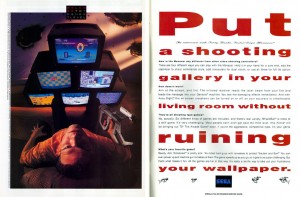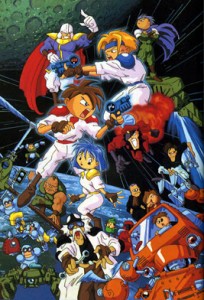 As a game producer, it can often be difficult to know which titles will be successful and which will flop. Sometimes though, one can tell a game has potential just by looking at it. There’s a certain mixture of elements that make the whole come together in a way that is instantly recognizable as something special. Some games just ooze quality, and those are the ones people remember.
As a game producer, it can often be difficult to know which titles will be successful and which will flop. Sometimes though, one can tell a game has potential just by looking at it. There’s a certain mixture of elements that make the whole come together in a way that is instantly recognizable as something special. Some games just ooze quality, and those are the ones people remember.
Mac Senour has had his fair share of experiences with games like that. A member of the first wave of Sega of America personnel that got the Genesis wheels turning, he eventually became the producer for such classic titles as Gunstar Heroes and Ranger-X. He had more than a few chances to make the decision between giving a game life and sending it to the reject pile. Thankfully, he was well adept at picking winners, and his work on bringing life to other licensed games help gave Sega an almost continuous line up of solid software for the Genesis and Game Gear.
Mr. Senour was kind enough to take some time and tell us about his experiences at Sega.
Sega-16: Evander Holyfield’s “Real Deal” Boxing was a major upgrade over the Buster Douglas game, which was essentially a port of Taito’s Final Blow Boxing. Was this title approached with just such an improvement in mind, or was the Bust Douglas game not a factor at all?
Mac Senour: I worked on the Game Gear version of Evander Holyfield’s Boxing, not the Genesis version. If I remember correctly, the Buster Douglas game was thought of as the bottom of the barrel. I recall hearing: “we have GOT to do better; that game is awful.”
In the middle of development we were visited by the ex-heavyweight champ, Joe Frazier. He wanted to see the game, but it was too early to show him so we showed him Streets of Rage instead. If you recall, that game, it’s not boxing at all. He said we had the fighting all wrong, and proceeded to set me up to mock fight him so he could show us what he would do in a fight. I took a boxers stance, and pretended to swing at him in slow motion. He ducked under my “punch” and hit me in the stomach three times very quickly. I didn’t eat lunch that day and I recall thinking, “please please don’t have a flash back and think I’m Ali.”
Sega-16: Taz Mania is regarded as a solid licensed game, one of a long line of such titles released by Sega on the Genesis, such as Castle of Illusion, Ghostbusters, and Moonwalker. Were licensed titles treated differently than others, or were they just considered to be just like any other?
Mac Senour: When we had a license, we dove deep into the pool. We were required to be an expert on the subject and of all previous games, regardless of the system. We played everything and watched episodes of every license. For Taz, I designed the first level of the Game Gear version to be a large rock chasing Taz down a hill. A year later, I saw that in an actual episode. I think that means the developer and I hit the mark square.
Sega-16: You were tasked with creating the pack-in game that came with the Sega Menacer light gun.What did you think of it as a peripheral? Did it seem like something that had potential to you, given the success of light gun games during the 8-bit era, or was Sega simply going with the flow to compete?
Mac Senour: I love the Menacer. It was dropped into my lap because I was “hardware boy” for a bit. I designed six games based on licenses we had done previous games on. I was also told to avoid shooting games. There were two games that made the final cut, ToeJam & Earl and the reverse block-out game. The title for the ToeJam & Earl game was created by Haven Carter, one of the best marketing people at SEGA.
It was certainly a reaction to Nintendo’s Super Scope, but it was intended to be more than a “me too” project. I made my presentation to the head of SEGA of Japan, sitting in my tiny cubicle. He said just one thing to me: “very good,” and he left.

Sega-16: How did you come up with the concepts for the Menacer six-game cart? Were ToeJam & Earl to be involved from the start, or were they added later during development?
Mac Senour: I wanted to use the licenses we had already. I had a Joe Montana Wide Receiver Training Camp. But when I first presented them I was asked: “Where are the shooting games?” When I pointed out they didn’t want them, I was told to make some shooting games and drop all but TJ&E from the list for cost reasons.
Sega-16: Joe Montana was going to have a Menacer game?
Mac Senour: Yep! I had one for Joe Montana, David Robinson… each of the six games had a license. The TJ&E one was the only one that was free, so it was allowed to continue.
Sega-16: Did Sega have any other Menacer games lined up? Virtually all the games compatible with it were released by other companies. Body Count was released by Sega in Europe and appeared in the U.S. on the Sega Channel, but it never saw a retail release. Do you know why no other games came out?
Mac Senour: Not a one. They laughed when I proposed more. When I left SEGA, I went to Atari/Tengen and was sent to Paris a day after joining. I was wandering around the Virgin Mega Store when I saw a TON of Menacers on display. I was with some French speakers and they were looking at the Menacer. I mentioned that I had produced all of the titles and the hardware, so they mentioned it to the clerk. I jokingly asked if she wanted me to autograph the boxes. She said in slow English: “You may autograph every one that you buy.” Cracked me up.
Sega-16: You commented once that the quality of game testers at Sega was… less than stellar, to say the least. You mentioned that the company went so far as to hire ditch diggers who barely spoke English. Was this a common practice at Sega? Was it like this at other companies?
Mac Senour: I think that quote got taken out of context. I never said ALL of the testers were less than stellar. As a matter of fact, they were amazing. I was the first producer to include all of their names in the game document. I had tremendous respect for them and the job they had to do.
At one point we had so many games in need of testing that we were hiring any warm body, including people who were digging ditches the day before. This isn’t a guess, I talked to one who was testing boxing for me, and he didn’t understand it was multi-player. His friend had to tell him in Spanish, and explained that the day before they were digging ditches.
Sega-16: You were the producer on Treasure’s first Genesis title (and its first game overall), Gunstar Heroes, and you mentioned that you took it on after all other producers had turned it down. Why do you think they passed on it? What made you so sure it would be a hit?
Mac Senour: Not just all the producers, all of the associate producers as well. 12 people looked at it and passed before it got to me. If I didn’t pick it up, he was going to be rejected. I played it for five minutes, maybe less, and threw the controller on the floor and said “this is game of the year.” Every one in earshot laughed.
The reason was made very clear to me. Gunstar had small characters. We had just published, or were about to publish, World Series Baseball with a HUGE batter. All the games were showing off something the developers of Spider-Man had discovered, a way to make double high sprites. Gunstar didn’t use this and so the others passed. I saw it as something different. I have to say I made only one real change: there’s a boss in a military uniform, and in the original version he was Hitler. I asked them to remove the mustache or change the character.
That “throw the controller on the floor” bit has become a habit. To the point that at MTV my bosses used to ask me if it was a throw-down game. There is no secret formula to a great game. I usually say I look for something old and something new and a great mix of both.
A lot of it is instinct. After I left SEGA I green lit Tomb Raider over my bosses objections. I green lit Spec Ops when no one was doing military games of that type, which led to Call of Duty. I took a simple entertainment, Potty Racers, and turned it into a game that was #1 overall app in Apple’s App Store.
I was trained well from the start by my producer at SEGA, Scott Berfield.
Sega-16: So Gunstar Heroes, considered today to be a Genesis classic, was only one producer away from being completely rejected? That’s amazing! How much did you interact with anyone from Treasure?
Mac Senour: I was the producer as I was on all of my other projects. I was the last guy; if I said no then it would have been canceled. They spoke no English, so I had to go through my contact at SOJ, Henry Gieson. Henry and I became friends when I was developer tech support.
As the tech support guy, EVERY third party game passed through my hands. I think that’s how I ended up as hardware boy. I’m the guy who figured out how to burn EPROMS so we could test games.
 Sega-16: The game started a long relationship between Treasure and Sega, which published all of the group’s Genesis games (McDonald’s Treasure Land Adventure, Dynamite Headdy, & Light Crusader). How highly regarded was Treasure at Sega?
Sega-16: The game started a long relationship between Treasure and Sega, which published all of the group’s Genesis games (McDonald’s Treasure Land Adventure, Dynamite Headdy, & Light Crusader). How highly regarded was Treasure at Sega?
Mac Senour: I left right when Gunstar when to manufacturing, so I can’t comment about Treasure. I know the first game – that won game of the year at two magazines -was lightly manufactured because of a lack of faith in the game. Gunstar was hard to find for this reason. Taz for the Game Gear had the same issue, marketing ordered just 63,000 copies. It went on to sell 1.1 million.
Sega-16: So management wasn’t really confident in Gunstar Heroes, and that resulted in a small initial print run . Was this perspective common with Japanese titles? Gamers often talk about all the great Japanese titles that never came to the U.S., despite not having large translation requirements (Pulseman, Golden Axe III).
Mac Senour: Yes very common. We got some really odd submissions from SOJ. Always a ton of side-scrolling shooters. Usually, the games made the rounds of the producers, turned down by all, and sent back to SOJ with a polite “NO.” One time they came to the U.S. to show us a game they said would change gaming forever. It was the most bizarre game I have ever seen. I can’t remember the title, but I remember it was all about practical jokes.
Sega-16: Tell us a bit about Ranger-X, another game you produced. Considered a Genesis classic, it seemed to go a bit under the radar at the time.
Mac Senour: I signed the release papers on my last official day as a SEGA employee for Ranger-X. I find it funny that I released a Game of Year title and a cult hit on the same day, and then my last day. Again, this was a title no one wanted, but unlike Gunstar, there was some reason we had to take it. It fell to me because I had an open slot. We were allowed four titles, and I had three, so Ranger-X fit in my last slot.
Sega-16: So Ranger-X was also a chance title? If you had passed on it, would it have suffered the same fate as Gunstar would have?
Mac Senour: There was some reason why we had to take Ranger-X. I don’t recall why, but it would not have been dropped like Gunstar would have been had I not picked it up. I guess that’s why everyone thought I was crazy when I said it would be game of the year.
Sega-16: You left Sega in 1993. Why?
Mac Senour: I left because I was told that my promotion to full producer was being held up because not all of the associate producers were ready to be promoted. I had about eight years more experience than the others and I was told that I had to wait. Atari offered me a 55% increase in pay and the title I felt I deserved.
Also, I had proposed the Shadowrun title, and it was given to Tony Van because he was a full producer, which upset me. And at a weekend retreat I had proposed a game where you play you. You get a house and a job, and the game is to keep the person happy and engaged. I called it Sim Life.
My boss said out loud: “that’s the dumbest idea for a game I have ever heard. Who would want to play that?” The answer, I’m sure you know, is about 179 million people, and it’s called The Sims. That boss, Clyde Grossman, has apologized several times since then. But at that time, I felt my idea was discarded too easily. I was pushed to present the idea by Ed Annunziotta, the guy who made Ecco and Spider-Man for SEGA, a guy who would know a good game from a bad one.
I proposed a Houdini game, and I was told he wasn’t popular. When they did a focus study Mickey Mouse got a 92.8 rating, Houdini got a 98.3. Houdini was more well known by our market than Mickey Mouse, but still I was not allowed to work on a Houdini game.
I left and designed Payne Stewart Golf, which later became PGA Golf for EA.
Many thanks to Mr. Senour for taking the time to chat with us!

Pingback: Gunstar Heroes Is An Exhilarating Ride That Never Lets Up | Kotaku Australia
Pingback: Trick5 – Gunstar Heroes Is An Exhilarating Ride That Never Lets Up – Trick5 | Trick5 Simplify The Technology
Good interview as always. It’s always nice to hear about games I grew up playing.
Pingback: Daily Retrospektive – 28/10/2013
So any idea what the bizarre game about practical jokes was?
Okay, first-party, Sega of Japan-developed game, early ’90s, about practical jokes, big change from usual gameplay.
Given that EGM was previewing it as early as around 1992 (I wanted it badly), and it didn’t get released in North America until 1994, with Data East, rather than Sega of America, finally giving it a Western release, and given that all of the things that happen to you when you push an incorrect button (which is most of the buttons in the game) could be taken to be practical jokes, that sounds like Panic! for the Sega CD to me (or Switch, as it was known in Japan).
Pingback: How Sega almost rejected Genesis classic Gunstar Heroes - The Console Insider
Pingback: Comment Sega a failli ne jamais sortir Gunstar Heroes aux US | Watz Up